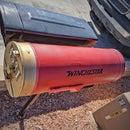Introduction: Portable Band Saw Chop Saw Stand
I never knew how much I needed a portable band saw - until I bought one. I'm THE dictionary description of a hobbyist/tinkerer/master of no skills, but absolutely enjoy making things myself rather than buying off the shelf if at all possible.
The past year I've finally had the time to pursue a bunch of projects for metal yard art and whatnot. I'm very space-limited for tools so the more compact and multi-use a tool is, the more likely it'll be in my shop. Using the band saw vs. circular cut off saw has been fantastic - faster, no shower of sparks, no cut off wheels exploding, etc.
I've seen numerous examples of hinged stands for these saws and knew I needed one so I could do projects with lots of identical parts (ex: rings out of pipe). This instructable is about how I went about it, and what I learned along the way.
Step 1: Front Hinge or Rear Hinge
The majority of on line designs hinge the saw from the trigger end - that's where all the weight is and there are multiple ways to attach a frame to the saw. The negative for me is the trigger access. Unless your saw has a lock-on style trigger, you're going to be fighting the trigger location and may end up getting a foot switch for convenience and safety.
The obvious mounting point to do a front hinge design is where the front handle attaches. Every design I looked at used some sort of u-bolt or clamp to fasten the unaltered handle to the frame. While I like that zero mods to a saw are required when doing this, I don't have the skill to weld up a tube frame quite yet.
The HF saw uses a 10mm/1.5 bolt, and my scrap bin was full of stout metal, including these 1" jack screws. I contoured the end of the screw to fit where the front handle goes, then used JB Weld to bed the screw and fill any gaps. The plastic wrap in the pic is so the putty didn't adhere to the saw - I want the stand removable.
Step 2: Flex Is Not Your Friend
I head to the hardware store and pick up a pair of the most rigid hinges I could find. "Oh, yeah" I'm thinking - "these babies are super stiff - probably overkill!" As the video shows - not even close. Played at 1/4 speed it was obvious the pogo'ing was from the spring in the hinges. So much for elegant and easy...
Before I gave up and started planning on a square tube frame style, I was advised to throw a dart and try to stiffen the hinges first. I figured I'd go all in with the welder and angle iron and see what happens.
I welded the jack screw mount to a cross brace welded to the hinges welded to 2 pieces of angle iron. Looking at the pics, now you know why my welding skills are suspect. (Hey, it's a flux core 90 amp HF $90 welder - I'm still learning.)
I mounted the vise and the hinges to some 3/4" plywood so I could give it another test. I intend to use plate steel as a base eventually - the wood was to be able to nail down the design one step at a time before doing anything irreversible.
Step 3: Well I'll Be...
The ugly added stiffeners completely did the trick. So far I tested it on angle iron, railroad spikes, and steel tubing - everything cuts with no more kickback. The weight of the saw is enough pressure when cutting, and the trigger is right where I'm used to it being with a chop saw.
I have retained to portability of the saw by removing a single bolt to move from frame to handle and back. Now when I want to cut 20 rings from a pipe, it's fun, not a chore. Hmmmm, you're thinking, all that weight on a single contact point? That was another question I couldn't answer until I made and used the stand. My layman's logic was: the entire saw can easily be held and swung around by the front handle alone, other stands hang the entire saw off that handle, etc.
I can only share my experience, which is that for a home shop hobbyist it's sturdy, durable, and not fragile. I probably wouldn't use a setup like mine in anything that approaches a commercial application - although I still do not have any worries about the strength of the connection.
So, for $30 I wound up with a chop saw stand that I would put up against the commercially available units for $250-$350.
Comment if you have any questions, concerns, or other tweaks. Thanks for looking.











